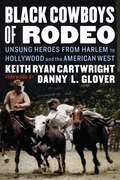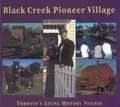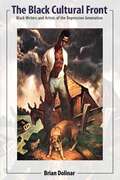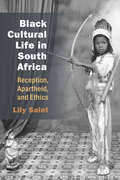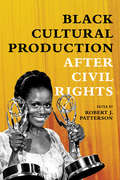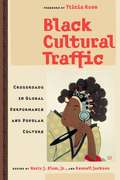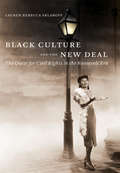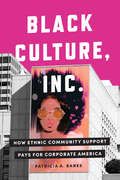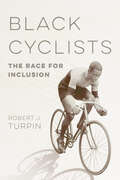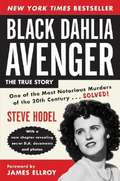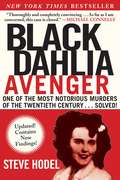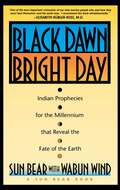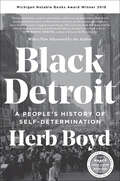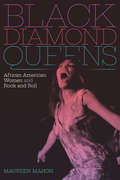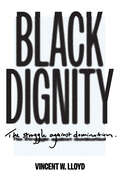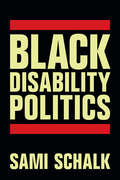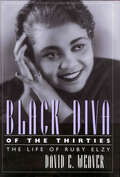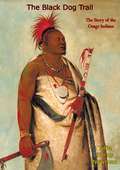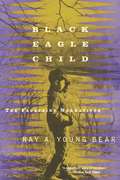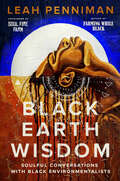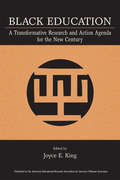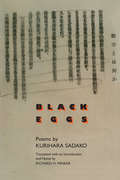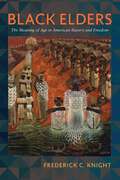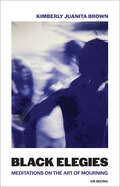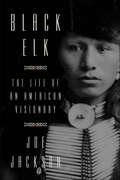- Table View
- List View
Black Cowboys of Rodeo: Unsung Heroes from Harlem to Hollywood and the American West
by Keith Ryan CartwrightThey ride horses, rope calves, buck broncos, ride and fight bulls, and even wrestle steers. They are Black cowboys, and the legacies of their pursuits intersect with those of America&’s struggle for racial equality, human rights, and social justice. Keith Ryan Cartwright brings to life the stories of such pioneers as Cleo Hearn, the first Black cowboy to professionally rope in the Rodeo Cowboy Association; Myrtis Dightman, who became known as the Jackie Robinson of Rodeo after being the first Black cowboy to qualify for the National Finals Rodeo; and Tex Williams, the first Black cowboy to become a state high school rodeo champion in Texas.Black Cowboys of Rodeo is a collection of one hundred years of stories, told by these revolutionary Black pioneers themselves and set against the backdrop of Reconstruction, Jim Crow, segregation, the civil rights movement, and eventually the integration of a racially divided country.
Black Creek Pioneer Village: Toronto's Living History Village
by Helma Mika Nick Mika Gary ThompsonBlack Creek Pioneer Village: Toronto’s Living History Village is a recreation of a typical crossroads community found in Southern Ontario during the 1800s. Nestled on 56 acres of tranquility, the village is a step-back-in-time, a respite from the towering buildings and bustling traffic of the 21st century. Here, visitors discover the joys and daily realities of living in early Ontario. Here at the village, the sights, sounds and smells are tangible reminders of our past. Meet the blacksmith, the tinsmith, the weaver, the miller, the printer … Meet the people who "live" at Black Creek and bring our yesteryears to life.
The Black Cultural Front: Black Writers and Artists of the Depression Generation (Margaret Walker Alexander Series in African American Studies)
by Brian DolinarThe Black Cultural Front describes how the social and political movements that grew out of the Depression facilitated the left turn of several African American artists and writers. The Communist-led John Reed Clubs brought together black and white writers in writing collectives. The Congress of Industrial Organizations's effort to recruit black workers inspired growing interest in the labor movement. One of the most concerted efforts was made by the National Negro Congress (NNC), a coalition of civil rights and labor organizations, which held cultural panels at its national conferences, fought segregation in the culture industries, promoted cultural education, and involved writers and artists in staging mass rallies during World War II.The formation of a black cultural front is examined by looking at the works of poet Langston Hughes, novelist Chester Himes, and cartoonist Ollie Harrington. While none of them were card-carrying members of the Communist Party, they all participated in the Left at one point in their careers. Interestingly, they all turned to creating popular culture in order to reach the black masses who were captivated by the movies, radio, newspapers, and detective novels. There are chapters on the Hughes' "Simple" stories, Himes' detective fiction, and Harrington's "Bootsie" cartoons.Collectively, the experience of these three figures contributes to the story of a "long" movement for African American freedom that flourished during the 1930s, 1940s, and 1950s. Yet this book also stresses the impact that McCarthyism had on dismantling the Black Left and how it affected each individual involved. Each was radicalized at a different moment and for different reasons. Each suffered for their past allegiances, whether fleeing to the haven of the "Black Bank" in Paris, or staying home and facing the House Un-American Activities Committee (HUAC). Yet the lasting influence of the Depression in their work was evident for the rest of their lives.
Black Cultural Life in South Africa: Reception, Apartheid, and Ethics (African Perspectives)
by Lily SaintUnder apartheid, black South Africans experienced severe material and social disadvantages occasioned by the government’s policies, and they had limited time for entertainment. Still, they closely engaged with an array of textual and visual cultures in ways that shaped their responses to this period of ethical crisis. Marshaling forms of historical evidence that include passbooks, memoirs, American “B” movies, literary and genre fiction, magazines, and photocomics, Black Cultural Life in South Africa considers the importance of popular genres and audiences in the relationship between ethical consciousness and aesthetic engagement. This study provocatively posits that states of oppression, including colonial and postcolonial rule, can elicit ethical responses to imaginative identification through encounters with popular culture, and it asks whether and how they carry over into ethical action. Its consideration of how globalized popular culture “travels” not just in material form, but also through the circuits of the imaginary, opens a new window for exploring the ethical and liberatory stakes of popular culture. Each chapter focuses on a separate genre, yet the overall interdisciplinary approach to the study of genre and argument for an expansion of ethical theory that draws on texts beyond the Western canon speak to growing concerns about studying genres and disciplines in isolation. Freed from oversimplified treatments of popular forms—common to cultural studies and ethical theory alike—this book demonstrates that people can do things with mass culture that reinvigorate ethical life. Lily Saint’s new volume will interest Africanists across the humanities and the social sciences, and scholars of Anglophone literary, globalization, and cultural studies; race; ethical theories and philosophies; film studies; book history and material cultures; and the burgeoning field of comics and graphic novels.
Black Cultural Production after Civil Rights
by Robert PattersonThe post-civil rights era of the 1970s offered African Americans an all-too-familiar paradox. Material and symbolic gains contended with setbacks fueled by resentment and reaction. African American artists responded with black approaches to expression that made history in their own time and continue to exercise an enormous influence on contemporary culture and politics.This collection's fascinating spectrum of topics begins with the literary and cinematic representations of slavery from the 1970s to the present. Other authors delve into visual culture from Blaxploitation to the art of Betye Saar to stage works like A Movie Star Has to Star in Black and White as well as groundbreaking literary works like Corregidora and Captain Blackman. A pair of concluding essays concentrate on institutional change by looking at the Seventies surge of black publishing and by analyzing Ntozake Shange's for colored girls… in the context of current controversies surrounding sexual violence. Throughout, the writers reveal how Seventies black cultural production anchors important contemporary debates in black feminism and other issues while spurring the black imagination to thrive amidst abject social and political conditions.Contributors: Courtney Baker, Soyica Diggs Colbert, Madhu Dubey, Nadine Knight, Monica White Ndounou, Kinohi Nishikawa, Samantha Pinto, Jermaine Singleton, Terrion L. Williamson, and Lisa Woolfork
Black Cultural Traffic: Crossroads in Global Performance and Popular Culture
by Kennell Jackson Jr. Harry J. ElamBlack Cultural Traffic is nothing less than our generation's manifesto on black performance and popular culture. With a distinguished roster of contributors and topics ranging across academic disciplines and the arts (including commentary on film, music, literature, theater, television, and visual cultures), this volume is not only required reading for scholars serious about the various dimensions of black performance, it is also a timely and necessary teaching tool. It captures the excitement and intellectual innovation of a field that has come of age.
Black Culture and The New Deal
by Lauren Rebecca SklaroffIn the 1930s, the Roosevelt administration--unwilling to antagonize a powerful southern congressional bloc--refused to endorse legislation that openly sought to improve political, economic, and social conditions for African Americans. Instead, as historian Lauren Rebecca Sklaroff shows, the administration recognized and celebrated African Americans by offering federal support to notable black intellectuals, celebrities, and artists. Sklaroff illustrates how programs within the Federal Arts Projects and several war agencies gave voice to such notable African Americans as Lena Horne, Joe Louis, Duke Ellington, and Richard Wright, as well as lesser-known figures. She argues that these New Deal programs represent a key moment in the history of American race relations, as the cultural arena provided black men and women with unique employment opportunities and new outlets for political expression. Equally important, she contends that these cultural programs were not merely an attempt to appease a black constituency but were also part of the New Deal's larger goal of promoting a multiracial nation. Yet, while federal projects ushered in creativity and unprecedented possibilities, they were also subject to censorship, bigotry, and political machinations. With numerous illustrations,Black Culture and the New Dealoffers a fresh perspective on the New Deal's racial progressivism and provides a new framework for understanding black culture and politics in the Roosevelt era.
Black Culture, Inc.: How Ethnic Community Support Pays for Corporate America (Culture and Economic Life)
by Patricia A. BanksA surprising and fascinating look at how Black culture has been leveraged by corporate America. Open the brochure for the Alvin Ailey American Dance Theater, and you'll see logos for corporations like American Express. Visit the website for the Apollo Theater, and you'll notice acknowledgments to corporations like Coca Cola and Citibank. The Martin Luther King, Jr. Memorial and the National Museum of African American History and Culture, owe their very existence to large corporate donations from companies like General Motors. And while we can easily make sense of the need for such funding to keep cultural spaces afloat, less obvious are the reasons that corporations give to them. In Black Culture, Inc., Patricia A. Banks interrogates the notion that such giving is completely altruistic, and argues for a deeper understanding of the hidden transactions being conducted that render corporate America dependent on Black culture. Drawing on a range of sources, such as public relations and advertising texts on corporate cultural patronage and observations at sponsored cultural events, Banks argues that Black cultural patronage profits firms by signaling that they value diversity, equity, and inclusion. By functioning in this manner, support of Black cultural initiatives affords these companies something called "diversity capital," an increasingly valuable commodity in today's business landscape. While this does not necessarily detract from the social good that cultural patronage does, it reveals its secret cost: ethnic community support may serve to obscure an otherwise poor track record with social justice. Banks deftly weaves innovative theory with detailed observations and a discerning critical gaze at the various agendas infiltrating memorials, museums, and music festivals meant to celebrate Black culture. At a time when accusations of discriminatory practices are met with immediate legal and social condemnation, the insights offered here are urgent and necessary.
Black Cyclists: The Race for Inclusion (Sport and Society)
by Robert J. TurpinCycling emerged as a sport in the late 1870s, and from the beginning, Black Americans rode alongside and raced against white competitors. Robert J. Turpin sheds light on the contributions of Black cyclists from the sport’s early days through the cementing of Jim Crow laws during the Progressive Era. As Turpin shows, Black cyclists used the bicycle not only as a vehicle but as a means of social mobility--a mobility that attracted white ire. Prominent Black cyclists like Marshall “Major” Taylor and Kitty Knox fought for equality amidst racist and increasingly pervasive restrictions. But Turpin also tells the stories of lesser-known athletes like Melvin Dove, whose actions spoke volumes about his opposition to the color line, and Hardy Jackson, a skilled racer forced to turn to stunt riding in vaudeville after Taylor became the only non-white permitted to race professionally in the United States. Eye-opening and long overdue, Black Cyclists uses race, technology, and mobility to explore a forgotten chapter in cycling history.
Black Dahlia Avenger: A Genius for Murder
by Steve HodelIn this startling tour-de-force, a professional homicide detective finally solves the case of one of the most shocking murders of the twentieth century in this true-crime page-turner.
Black Dahlia Avenger: One of the Most Notorious Murders of the Twentieth Century . . . Solved! (Black Dahlia Avenger Ser.)
by Steve HodelIn 1947, the brutal, sadistic murder of a beautiful young woman named Elizabeth Short led to the largest manhunt in LA history. The killer teased and taunted the police and public for weeks, but his identity stayed a mystery, and the murder remained the most tantalizing unsolved case of the last century, until this book revealed the bizarre solution. Steve Hodel, a retired LAPD detective who was a private investigator, took up the case, reviewing the original evidence and records as well as those of a separate grand jury investigation into a series of murders of single women in LA at the time. The prime suspect had in fact been identified, but never indicted. Why? And who was he? In an account that partakes both of LA Confidential and Zodiac, for the corruption it exposes and the insight it offers into a serial killer’s mind, Hodel demonstrates that there was a massive police cover-up. Even more shocking, he proves that the murderer, a true-life Jekyll and Hyde who was a highly respected member of society by day and a psychopathic killer by night, was his own father. This edition of the book includes new findings and photographs added after the original publication, together with a new postscript by the author.
Black Dawn, Bright Day: Indian Prophecies for the Millennium that Reveal the Fate of the Earth
by Sun Bear Wabun WindA compelling and prophetic work that details the environmental future of every major landmass in the world.The sacred teacher and author of The Medicine Wheel offers a compelling and prophetic work that details the environmental future of every major landmass in the world. Through his own visions and dreams, and the visions of other Native American peoples, Sun Bear has seen the future of our Earth, and here he explicitly details which parts of the world will be most affected.
Black Detroit: A People's History of Self-Determination
by Herb BoydNAACP Image Award Finalist: “Boyd’s riveting new history…turns an oft-caricatured community into a world of actual, struggling human beings.”—Ta-Nehisi Coates, author of Between the World and MeA Michigan Notable Books HonoreeIn this book, the author of Baldwin’s Harlem looks at the evolving culture, politics, economics, and spiritual life of Detroit—in “a blend of memoir, love letter, history, and clear-eyed reportage that explores the city’s past, present, and future and its significance to the African American legacy and the nation’s fabric” (Detroit Free Press).Herb Boyd moved to Detroit in 1943, as race riots were engulfing the city. Though he did not grasp their full significance at the time, this critical moment would be one of many he witnessed that would mold his political activism and exposed a city restless for change. In Black Detroit, he reflects on his life and this landmark place, in search of understanding why Detroit is a special place for black people.He reveals how Black Detroiters were prominent in the city’s historic, groundbreaking union movement and—when given an opportunity—were among the tireless workers who made the automobile industry the center of American industry. Well-paying jobs on assembly lines allowed working-class Black Detroiters to ascend to the middle class and achieve financial stability, an accomplishment not often attainable in other industries.Boyd makes clear that while many of these middle-class jobs have disappeared, decimating the population and hitting blacks hardest, Detroit survives thanks to the emergence of companies such as Shinola—which represent the strength of the Motor City and its continued importance to the country. He also brings into focus the major figures who have defined and shaped Detroit, including William Lambert, the great abolitionist, Berry Gordy, the founder of Motown, Coleman Young, the city’s first black mayor, diva songstress Aretha Franklin, Malcolm X, and Ralph Bunche, winner of the Nobel Peace Prize.“The characters who walk across Boyd’s pages are fascinating.” —The New York Times Book Review“Comprehensive and compelling.”—The Washington Post
Black Diamond Queens: African American Women and Rock and Roll (Refiguring American Music)
by Maureen MahonAfrican American women have played a pivotal part in rock and roll—from laying its foundations and singing chart-topping hits to influencing some of the genre's most iconic acts. Despite this, black women's importance to the music's history has been diminished by narratives of rock as a mostly white male enterprise. In Black Diamond Queens, Maureen Mahon draws on recordings, press coverage, archival materials, and interviews to document the history of African American women in rock and roll between the 1950s and the 1980s. Mahon details the musical contributions and cultural impact of Big Mama Thornton, LaVern Baker, Betty Davis, Tina Turner, Merry Clayton, Labelle, the Shirelles, and others, demonstrating how dominant views of gender, race, sexuality, and genre affected their careers. By uncovering this hidden history of black women in rock and roll, Mahon reveals a powerful sonic legacy that continues to reverberate into the twenty-first century.
Black Dignity: The Struggle against Domination
by Vincent W. LloydWhy Black dignity is the paradigm of all dignity and Black philosophy is the starting point of all philosophy &“A bold attempt to determine the conditions of—and the means for achieving—racial justice.&”—Kirkus Reviews This radical work by one of the leading young scholars of Black thought delineates a new concept of Black dignity, yet one with a long history in Black writing and action. Previously in the West, dignity has been seen in two ways: as something inherent in one&’s station in life, whether acquired or conferred by birth; or more recently as an essential condition and right common to all of humanity. In what might be called a work of observational philosophy—an effort to describe the philosophy underlying the Black Lives Matter movement—Vincent W. Lloyd defines dignity as something performative, not an essential quality but an action: struggle against domination. Without struggle, there is no dignity. He defines anti-Blackness as an inescapable condition of American life, and the slave&’s struggle against the master as the &“primal scene&” of domination and resistance. Exploring the way Black writers such as Frederick Douglass, Langston Hughes, and Audre Lorde have dealt with themes such as Black rage, Black love, and Black magic, Lloyd posits that Black dignity is the paradigm of all dignity and, more audaciously, that Black philosophy is the starting point of all philosophy.
Black Disability Politics
by Sami SchalkIn Black Disability Politics Sami Schalk explores how issues of disability have been and continue to be central to Black activism from the 1970s to the present. Schalk shows how Black people have long engaged with disability as a political issue deeply tied to race and racism. She points out that this work has not been recognized as part of the legacy of disability justice and liberation because Black disability politics differ in language and approach from the mainstream white-dominant disability rights movement. Drawing on the archives of the Black Panther Party and the National Black Women’s Health Project alongside interviews with contemporary Black disabled cultural workers, Schalk identifies common qualities of Black disability politics, including the need to ground public health initiatives in the experience and expertise of marginalized disabled people so that they can work in antiracist, feminist, and anti-ableist ways. Prioritizing an understanding of disability within the context of white supremacy, Schalk demonstrates that the work of Black disability politics not only exists but is essential to the future of Black liberation movements.
Black Diva of the Thirties: The Life of Ruby Elzy (Willie Morris Books in Memoir and Biography)
by David E. WeaverWhile undergoing routine surgery to remove a benign tumor, Ruby Elzy died. She was only thirty-five. Had she lived, she would have been one of the first Black artists to appear in grand opera. Although now in the shadows, she was a shining star in her day. She entertained Eleanor Roosevelt in the White House. She was Paul Robeson's leading lady in the movie version of The Emperor Jones. She starred in Birth of the Blues opposite Bing Crosby and Mary Martin. She sang at Harlem's Apollo Theater and in the Hollywood Bowl. Her remarkable soprano voice was known to millions over the radio. She was personally chosen by George Gershwin to create one of the leading roles in his masterpiece, that of Serena in the original production of Porgy and Bess. Her signature song was the vocally demanding “My Man's Gone Now.” From obscurity she had risen to great heights. Ruby Pearl Elzy (1908-1943) was born in abject poverty in Pontotoc, Mississippi. Her father abandoned the family when she was five, leaving her mother, a strong, devout woman, to raise four small children. Ruby first sang publicly at the age of four and even in childhood dreamed of a career on the stage. Good fortune struck when a visiting professor, overwhelmed upon hearing her beautiful voice at Rust College in Mississippi, arranged for her to study music at Ohio State University. Later, on a Rosenwald Fellowship, she enrolled at the Juilliard School in New York City. After more than eight hundred performances in Porgy and Bess, she set her sights on a huge goal, to sing in grand opera. She was at the peak of her form. While she was preparing for her debut in the title role of Verdi's Aida, tragedy struck. During her brief career, Ruby Elzy was in the top tier of American sopranos and a precursor who paved a way for Leontyne Price, Jessye Norman, Kathleen Battle, and other black divas of the operatic stage. This biography acknowledges her exceptional talent, recognizes her contribution to American music, and tells her tragic yet inspiring story.
The Black Dog Trail: The Story of the Osage Indians
by Tillie Karns NewmanFascinating and detailed account of the Osage Indians spanning present day Kansas and Oklahoma, centring on the leadership of Black Dog the elder and his son also named Black Dog.“It was the first Chief Black Dog who conceived and engineered the Black Dog Trail for hunting and mourning parties. It was he who directed the building of a race track for young braves to develop speed in running and other athletics. And it was he who understood the significance of the Mottled Eagle (Hon-’ga) from which he descended.During his life time, he led the Osages courageously and unselfishly through disasters and trying events into worthwhile undertakings and happy surroundings.The second Chief Black Dog, upon the death of his father, fell heir to leadership and much trouble, in the beginning. However, he was resourceful with foresight and decision, and was able during the Civil War and the turn of the century to guide his people into greener pastures than those frequently noted by historians. He encountered many difficulties, temptations and disappointments; he left no male descendant to carry on the prized name of “Black Dog.”He lived until 1910, long enough to lend his influence with the Osage Nation towards making an oil and gas lease on a million and a half acres of their land, and by this counsel helped his people to become the wealthiest of all Indian tribes.”
Black Eagle Child
by Ray A. Young BearStories of life on a Native American settlement during the 50s,60s and 70s. Told in poetry in prose.
Black Earth Wisdom: Soulful Conversations with Black Environmentalists
by Leah PennimanA soulful collection of illuminating essays and interviews that explore Black people’s spiritual and scientific connection to the land, waters, and climate, curated by the acclaimed author of Farming While BlackAuthor of Farming While Black and co-founder of Soul Fire Farm, Leah Penniman reminds us that ecological humility is an intrinsic part of Black cultural heritage. While racial capitalism has attempted to sever our connection to the sacred earth for 400 years, Black people have long seen the land and water as family and understood the intrinsic value of nature.This thought-provoking anthology brings together today’s most respected and influential Black environmentalist voices —leaders who have cultivated the skill of listening to the Earth —to share the lessons they have learned. These varied and distinguished experts include Pulitzer Prize and National Book Award-winning author Alice Walker; the first Queen Mother and official spokesperson for the Gullah/Geechee Nation, Queen Quet; marine biologist, policy expert, and founder and president of Ocean Collectiv, Dr. Ayana Elizabeth Johnson; and the Executive Director of the North Carolina Association of Black Lawyers, Land Loss Prevention Project, Savi Horne. In Black Earth Wisdom, they address the essential connection between nature and our survival and how runaway consumption and corporate insatiability are harming the earth and every facet of American society, engendering racial violence, food apartheid, and climate injustice.Those whose skin is the color of soil are reviving their ancestral and ancient practice of listening to the earth for guidance. Penniman makes clear that the fight for racial and environmental justice demands that people put our planet first and defer to nature as our ultimate teacher.Contributors include:Alice Walker • adrienne maree brown • Dr. Ross Gay • Dr. Ayana Elizabeth Johnson • Rue Mapp • Dr. Carolyn Finney • Audrey Peterman • Awise Agbaye Wande Abimbola • Ibrahim Abdul-Matin • Kendra Pierre-Louis • Latria Graham • Dr. Lauret Savoy •Ira Wallace • Savi Horne • Dr. Claudia Ford • Dr. J. Drew Lanham • Dr. Leni Sorensen • Queen Quet • Toshi Reagon • Yeye Luisah Teish • Yonnette Fleming • Naima Penniman • Angelou Ezeilo • James Edward Mills • Teresa Baker • Pandora Thomas • Toi Scott • Aleya Fraser • Chris Bolden-Newsome • Dr. Joshua Bennett • B. Anderson • Chris Hill • Greg Watson • T. Morgan Dixon • Dr. Dorceta Taylor • Colette Pichon Battle • Dillon Bernard • Sharon Lavigne • Steve Curwood • and Babalawo Enroue Halfkenny
Black Education: A Transformative Research and Action Agenda for the New Century
by Joyce E. KingThis volume presents the findings and recommendations of the American Educational Research Association's (AERA) Commission on Research in Black Education (CORIBE) and offers new directions for research and practice. By commissioning an independent group of scholars of diverse perspectives and voices to investigate major issues hindering the education of Black people in the U.S., other Diaspora contexts, and Africa, the AERA sought to place issues of Black education and research practice in the forefront of the agenda of the scholarly community. An unprecedented critical challenge to orthodox thinking, this book makes an epistemological break with mainstream scholarship. Contributors present research on proven solutions--best practices--that prepare Black students and others to achieve at high levels of academic excellence and to be agents of their own socioeconomic and cultural transformation. These analyses and empirical findings also link the crisis in Black education to embedded ideological biases in research and the system of thought that often justifies the abject state of Black education.Written for both a scholarly and a general audience, this book demonstrates a transformative role for research and a positive role for culture in learning, in the academy, and in community and cross-national contexts. Volume editor Joyce E. King is the Benjamin E. Mays Endowed Chair of Urban Teaching, Learning and Leadership at Georgia State University and was chair of CORIBE. Additional Resources Black Education [CD-ROM]Research and Best Practices 1999-2001Edited byJoyce E. KingGeorgia State UniversityInformed by diverse perspectives and voices of leading researchers, teacher educators and classroom teachers, this rich, interactive CD-ROM contains an archive of the empirical findings, recommendations, and best practices assembled by the Commission on Research in Black Education. Dynamic multi-media presentations document concrete examples of transformative practice that prepare Black students and others to achieve academic and cultural excellence. This CD-ROM was produced with a grant from the SOROS Foundation, Open Society Institute.0-8058-5564-5 [CD-ROM] / 2005 / Free Upon Request A Detroit Conversation [Video]Edited byJoyce E. KingGeorgia State University In this 20-minute video-documentary a diverse panel of educators--teachers, administrators, professors, a "reform" Board member, and parent and community activists--engage in a "no holds barred" conversation about testing, teacher preparation, and what is and is not working in Detroit schools, including a school for pregnant and parenting teens and Timbuktu Academy. Concrete suggestions for research and practice are offered.0-8058-5625-0 [Video] / 2005 / $10.00 A Charge to Keep [Video]The Findings and Recommendations of te AERA Commission on Research in Black EducationEdited byJoyce E. KingGeorgia State University This 50-minute video documents the findings and recommendations of the Commission on Research in Black Education (CORIBE), including exemplary educational approaches that CORIBE identified, cameo commentaries by Lisa Delpit, Gloria Ladson-Billings, Kathy Au, Donna Gollnick, Adelaide L. Sanford, Asa Hilliard, Edmund Gordon and others, and an extended interview with Sylvia Wynter.0-8058-5626-9 [Video] / 2005 / $10.00
Black Eggs: Poems by Kurihara Sadako (Michigan Monograph Series in Japanese Studies)
by Sadako KuriharaKurihara Sadako was born in Hiroshima in 1913, and she was there on August 6, 1945. Already a poet before she experienced the atomic bombing of Hiroshima, she used her poetic talents to describe the blast and its aftermath. In 1946, despite the censorship of the American Occupation, she published Kuroi tamago (Black Eggs), poems from before, during, and immediately after the war. This volume includes a translation of Kuroi tamago from the complete edition of 1983. But August 6, 1945, was not the end point of Kurihara’s journey. In the years after Kuroi tamago she has broadened her focus—to Japan as a victimizer rather than victim, to the threat of nuclear war, to antiwar movements around the world, and to inhumanity in its many guises. She treats events in Japan such as politics in Hiroshima, Tokyo’s long-term complicity in American policies, and the decision in 1992 to send Japanese troops on U.N. peacekeeping operations. But she also deals with the Vietnam War, Three Mile Island, Kwangju, Greenham Common, and Tiananmen Square. This volume includes a large selection of these later poems. Kurihara sets us all at ground zero, strips us down to our basic humanity, and shows us the world both as it is and as it could be. Her poems are by turns sorrowful and sarcastic, tender and tough. Several of them are famous in Japan today, but even there, few people appreciate the full force and range of her poetry. And few poets in any country—indeed, few artists of any kind—have displayed comparable dedication, consistency, and insight.
Black Elders: The Meaning of Age in American Slavery and Freedom (Early American Studies)
by Frederick KnightWould there have been a Frederick Douglass if it were not for Betsy Bailey, the grandmother who raised him? Would Harriet Jacobs have written her renowned autobiography, Incidents in the Life of a Slave Girl, if her grandmother, a free black woman named Molly Horniblow, had not enabled Jacobs’ escape from slavery?In Black Elders, Frederick C. Knight explores the experiences of African Americans with aging and in old age during the eras of slavery and emancipation. Though slavery put a premium on young labor, elders worked as caregivers, domestics, cooks, or midwives and performed other tasks in the margins of Southern and Northern economies. Looking at black families, churches, mutual aid societies, and homes for the aged, Knight demonstrates the pivotal role of elders in the history of African American community formation through Reconstruction.Drawing on a wide array of printed and archival sources, including slave narratives, plantation records, letters, diaries, meeting minutes, and state and federal archives, Knight also examines how blacks and whites, men and women, the young and the old developed competing ideas about age and aging, differences that shaped social relations in coastal West and West Central Africa, the Atlantic and domestic slave trades, colonial and antebellum Southern slave societies, and emancipation in the North and South.Black Elders offers a unique window into the individual and collective lives of African Americans, the day-to-day struggles they waged around their experiences of aging, and how they drew upon these resources to define the meaning of family, community, and freedom.
Black Elegies: Meditations on the Art of Mourning (On Seeing)
by Kimberly Juanita BrownA poignant, unflinching study of black grief as a form of elegy found in visual art, music, literature—everywhere, if you know how to see it.In Black Elegies, Kimberly Juanita Brown examines the form of the elegy and its unique capacity to convey the elongated grief borne of sustained racial violence. Structured around the sensorial, the book moves through sight, sound, and touch to reveal what Okwui Enwezor calls the &“national emergency of black grief.&” With her characteristic literary skill, Brown analyzes the work of major figures including Toni Morrison, Carrie Mae Weems, Audre Lorde, and Marvin Gaye, among others.Brown contemplates recognizable sites of mourning: forced migration and enslavement, bodily violations, imprisonment and death. And she examines sites that do not register immediately as archives of grief: the landscape of southern U.S. slave plantations, a spontaneous street party, a quilt constructed out of the clothing worn by a loved one, a dance performance to hold the memory of history, and an aeolian harp installed at an institute of European art, among others. In this, the book offers a framework of mourning while black, within the parameters of contemporary artistic production. Brown asks: How do you mourn those you are not supposed to see? And where does the grief go? She shows us that grief is everywhere: &“It spills out of photographs and modulates music. It hovers in the tenor and tone of cinematic performances. It resides in the body like an inspired concept, waiting for its articulation.&”
Black Elk: The Life of an American Visionary
by Joe JacksonWinner of the Society of American Historians' Francis Parkman PrizeWinner of the PEN / Jacqueline Bograd Weld Award for BiographyBest Biography of 2016, True West magazine Winner of the Western Writers of America 2017 Spur Award, Best Western BiographyFinalist, National Book Critics Circle Award for BiographyLong-listed for the Cundill History PrizeOne of the Best Books of 2016, The Boston GlobeThe epic life story of the Native American holy man who has inspired millions around the worldBlack Elk, the Native American holy man, is known to millions of readers around the world from his 1932 testimonial Black Elk Speaks. Adapted by the poet John G. Neihardt from a series of interviews with Black Elk and other elders at the Pine Ridge Reservation in South Dakota, Black Elk Speaks is one of the most widely read and admired works of American Indian literature. Cryptic and deeply personal, it has been read as a spiritual guide, a philosophical manifesto, and a text to be deconstructed—while the historical Black Elk has faded from view.In this sweeping book, Joe Jackson provides the definitive biographical account of a figure whose dramatic life converged with some of the most momentous events in the history of the American West. Born in an era of rising violence between the Sioux, white settlers, and U.S. government troops, Black Elk killed his first man at the Little Bighorn, witnessed the death of his second cousin Crazy Horse, and traveled to Europe with Buffalo Bill’s Wild West show. Upon his return, he was swept up in the traditionalist Ghost Dance movement and shaken by the Massacre at Wounded Knee. But Black Elk was not a warrior, instead accepting the path of a healer and holy man, motivated by a powerful prophetic vision that he struggled to understand. Although Black Elk embraced Catholicism in his later years, he continued to practice the old ways clandestinely and never refrained from seeking meaning in the visions that both haunted and inspired him.In Black Elk, Jackson has crafted a true American epic, restoring to its subject the richness of his times and gorgeously portraying a life of heroism and tragedy, adaptation and endurance, in an era of permanent crisis on the Great Plains.
